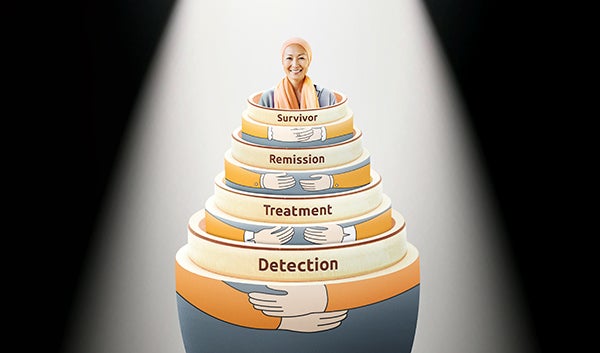Covering Your Bases: How Insurance Fills Protection Gaps in Singapore
Navigating the financial landscape in Singapore comes with a set of unique challenges. For singles without children, when it comes to determining how much insurance coverage you need to be well-protected, you have to consider your retirement plans, and what it takes to care for ageing parents, which adds a layer of financial complexity.
On the other hand, as parents you face the challenges associated with being part of the ‘sandwich generation’, namely the dual responsibility of providing for your children's future while potentially supporting your own ageing parents. The costs associated with raising children, including education and healthcare expenses, can be substantial. Balancing these financial demands while planning for retirement can be especially challenging.
This is why it's imperative for both segments to address protection gaps early, so you are not vulnerable to unforeseen medical crises.
What Is A Protection Gap?
A protection gap is simply the difference between the financial resources that you have and the resources you need, in the event of a medical crisis, like a critical illness or injury.
Let’s take for example, James who has a total of $300,000 worth of critical illness insurance coverage and cash savings. If he gets diagnosed with cancer unexpectedly, the costs may add up to $1M for medical bills plus living expenses for him and his family. Here, James’ protection gap is $700,000, the sum that he needs to fork out on his own to get the treatment he needs and to ensure his family can continue to sustain while he recovers.
A recent study by the Life Insurance Association (LIA) underlined that economically active adults in Singapore have an average mortality protection gap of 21% and a critical illness (CI) protection gap of 74%. These gaps amount to S$169,673 and S$256,826 respectively. These staggering figures suggest that there is room for improvement when it comes to preparing Singaporeans to guard against financial impacts arising from medical crises.
Some common reasons why working adults may avoid thinking about addressing their protection gaps:
- A reluctance to broach topics involving injury, illness, or mortality
- Some might believe that their youth and good health allow them to delay obtaining insurance
- Uncertainty on how much insurance coverage is appropriate
- Perceived high costs and complexity of insurance
Although these concerns may be understandable, neglecting insurance coverage entirely can do more harm than good.
How Can I Know What My Protection Gap Is?
To conveniently assess if you have a protection gap, you can consider using this Protection Gap Calculator1. In just 3 minutes, you will be able to have a broad overview of any potential gaps.
Remember, different life stages and milestones, such as marriage, parenthood, or caregiving for elderly parents, can alter your protection gaps. So doing regular checks on your protection gaps can ensure that your coverage aligns with your changing circumstances.
How To Calculate Your Protection Gaps
Understanding your protection gap can be simplified to 3 simple steps:
Step 1: Calculate the Necessary Resources
The Life Insurance Association offers a simple guideline to determine the resources required in case of death or critical illness.
To secure your family's financial stability after an unexpected passing, it's advised to have resources equal to 9 times your annual income. For critical illness, a recommended amount of coverage is at 3.4 times your annual income. This ensures you and your loved ones can manage financially while adjusting to significant life changes.
Step 2: Evaluate Your Existing Resources
Once you know what's needed, evaluate your current resources. This encompasses cash savings, easily convertible assets, and insurance coverage payouts (such as those for death, disability, or critical illness).
Add up these resources to understand the financial support available to you and your family.
Step 3: Calculate Your Protection Gap
With figures from Steps 1 and 2, apply the formula to find your protection gap:
Protection Gap = Needed Protection or Resources - Available Resources
If the result is positive, you may have a protection gap which you should look out for.
What Can You Do About A Protection Gap?
If you've identified a protection gap, your next step is to bridge that gap with the right insurance products, with the help of a qualified financial advisor. To do so, consider factors like your budget, the number of dependents you have, and the type of coverage that aligns best with your circumstances.
Plan for the Long-Term with The Right Insurance Solutions
Generally, the key categories of protection insurance include, but are not limited to, health and life insurance.
Hospitalisation insurance, which falls under health insurance, shields against unforeseen medical expenses, inpatient hospital costs, and medical expenses that may not be covered by other policies, ensuring financial stability during health crises.
As for life insurance, Income's Term Life Insurance policies are good all-rounded options you can consider to plug your protection gaps.
Plans like Complete Cancer Care can play a pivotal role in ensuring families remain well-supported should illness or injury strike.
Complete Cancer Care may alleviate some of the financial burdens associated with cancer treatment:
- First in Singapore to provide guaranteed post-cancer cover option2 - purchase a new term plan for extra coverage upon the diagnosis of advanced stage major cancer.
- Receive up to 1% of the sum assured per month for up to 24 months3 to help reduce the out-of-pocket expenses for cancer treatment.
- Receive 10% of the sum assured4 for hospice and palliative care.
For those with children, term life insurance plans such as TermLife Solitaire could help safeguard your family's financial well-being in the event of death and terminal illness with a sum assured5 of at least $500,000.
You may also wish to consider exploring Income’s Complete Life Secure, a whole life insurance plan that provides lifelong protection across various life stages with the added benefit of accumulating cash value over time. Enhance your coverage for added peace of mind with the Early Critical Secure rider6 and Advanced Critical Secure rider7 add-ons:
- Be covered for up to 159 conditions, which include early, intermediate and advanced stage dread diseases6,7,8.
- [First in Singapore among the whole life insurance plans] Receive extra protection for advanced stage dread disease8,9 (major cancer, heart attack of specified severity and stroke with permanent neurological deficit), even after making an early or intermediate stage dread disease claim.
- [First in Singapore] Guaranteed option to purchase a specified new term plan covering death and terminal illness after a diagnosis of early, intermediate or advanced stage dread disease with the Guaranteed Post-Early DD Cover Option10.
- Cover more ground with additional coverage for mental11, special11 and juvenile12 conditions.
Furthermore, Income also provides insurance savings plans such as Gro Saver Flex Pro that helps you stay protected13 against death and terminal illness, providing peace of mind.
Lastly, when it comes to your health and the health of your loved ones, you want to be able to access the best healthcare solutions when you need to. However, your MediShield Life insurance primarily covers expected treatment expenses in Class B2 or C wards of public hospitals. This is where a private Integrated Shield Plan (IP) can bridge the gap. Enhanced IncomeShield is one such plan, offering you the flexibility to access private healthcare without the fear of overwhelming medical bills as it increases your policy's yearly claimable amount from $150,000 (with MediShield Life) to a maximum of $1,500,000.
As life circumstances change and new insurance options emerge, seeking guidance from an advisor for an annual review becomes crucial, ensuring you maintain the right level of protection without overburdening yourself or leaving gaps in coverage.
Safeguarding Your Future: Take Action Today
Take care of your financial protection gaps, with the right insurance coverage. Explore Income's range of insurance products now, or speak with any of our advisors about potential protection gaps, and what you can do about it.
Don't wait until uncertainties knock on your door. Take steps today to safeguard your financial well-being and that of your loved ones.
1 The figures generated by the calculator are estimates and offer a rough idea of your protection gap(s). For detailed analysis and personalised solutions, please contact a qualified advisor.
2 Upon diagnosis with advanced stage major cancer, the insured may choose to take up a new term policy with only death, terminal illness and total and permanent disability (TPD) benefits on the insured own life, without Income having to assess their health. The waiting period of the new term policy is 2 years. If the insured makes a claim on the new term policy during the 2 years of waiting period, Income will refund 100% of the premiums paid on the term policy issued under this option.
The sum assured for the new term policy will be limited to:
- 100% of the sum assured for this policy; or
- $200,000 per life
aggregating policies issued under the guaranteed post-cancer cover option, whichever is lower.
Income will decide the type of new policy to be offered and the insured must meet all the following conditions to take up this option:
- The insured must take up this option within 6 months from the date of claim admittance of the advanced stage major cancer benefit.
- The insured must not be totally and permanently disabled, terminally ill or be diagnosed with an advanced-stage dread disease other than major cancer, at the time of taking up this option.
- The insured must be 60 years old last birthday or under at the time of taking up this option.
3 Income will pay a Monthly Cancer Therapy Benefit as long as the insured is diagnosed with major cancer by a specialist and recommended in writing that the treatment is a necessary medical treatment for cancer according to relevant guidelines from Ministry of Health (MOH) and has started cancer treatment as advised by a specialist. Income will make the first payment starting from the policy month immediately after the cancer treatment start date. For more details on the types of cancer treatment, please refer to the policy conditions. The maximum amount Income will pay for this benefit is $60,000 per life. Income will not pay more than a total number of 12 payouts for early or intermediate stage major cancer. If the insured has already received payouts during early stage, there will not be further payouts during intermediate stage. The sum of the total number of payouts for this benefit will not exceed 24 payouts. The number of payouts for the advanced stage major cancer will be 24 less the number of payouts Income have paid for the early or intermediate stage major cancer under this benefit. Income will not pay this benefit if the insured suffered symptoms of, had investigations for, or was diagnosed with, any stage of major cancer any time before or within 90 days from the cover start date. Please refer to the policy conditions for further details.
4 Income will pay 10% of the sum assured if the insured is successfully admitted to an inpatient palliative care facility or engaged the home palliative or day palliative care services from providers listed by Singapore Hospice Council (SHC) during the policy term. The insured must be diagnosed with terminal cancer by a specialist and a referral for palliative care services made by a specialist is required. Providers listed by SHC, which may be updated from time to time, can be found at singaporehospice.org.sg/services. The benefit will terminate after this benefit is claimed in full. Income will not pay this benefit if the insured suffered symptoms of, had investigations for, or was diagnosed with, any stage of major cancer any time before or within 90 days from the cover start date.
5 If the insured becomes terminally ill or dies during the term of the policy, Income Insurance will pay the sum assured. The policy will end when Income Insurance make this payment.
6 Any payment made for Dread Disease Benefit under this rider will form an accelerated payment, and reduce the sum assured and any bonuses of this rider and its basic policy by the same amount that we pay under this rider. For policies issued by us that include early and/or intermediate dread disease of the same dread disease, we will pay no more than $350,000 for the same dread disease for each insured (no matter how many policies we have issued to cover each insured).
Please refer to the policy conditions for further details.
7 Any payment under this rider will form an accelerated payment, and reduce the sum assured and any bonuses of this rider and its basic policy by the same amount that we pay under this rider. Please refer to the policy conditions for further details.
8 The total benefits (in relation to any dread disease benefits or equivalent benefits) under all policies, whether issued and paid by us or any other insurer, cannot be more than $3.6 million (including premiums waived due to dread disease but excluding bonuses) (“Dread Disease Per Life Limit”). Please refer to the policy conditions for further details.
9 You can only make a claim under the Advanced Restoration Benefit if you have previously succeeded in claiming the Dread Disease Benefit for an early or intermediate stage dread disease and if your basic policy has not ended. We will only pay for this benefit once and this rider will end. Any amount we pay under Advanced Restoration Benefit will reduce the Dread Disease Per Life Limit. Please refer to the policy conditions for further details.
10 Upon diagnosis of the insured with early, intermediate or advanced stage dread disease covered under Dread Disease Benefit, a new term policy covering the insured may be taken up with only death and terminal illness benefits, without us having to assess the insured’s health. Total and permanent disability will not be covered by the new term policy. The new term policy will include a waiting period of 2 years, within which we will not pay any claims. If an event giving rise to a claim occurs during the 2-year waiting period, we will not pay any claim under the new term policy, the new term policy will end and we will refund 100% of the premiums paid for the new term policy. We reserve the right to decide the type of new term policy to be offered and the insured must meet all the conditions to take up this option as listed in the policy conditions. Please refer to the policy conditions for further details.
11 For policies issued by us that include Special Benefit or Special and Mental Benefit, we will pay no more than the maximum claim limit for the same condition or procedure for each insured, no matter how many of such policies we have issued to cover the same insured.
At most, we will pay the Special Benefit five times, as long as each claim is not for the same Special Benefit as any of the earlier claims.
At most, we will pay the Mental Benefit three times, as long as each claim is not for the same Mental Benefit as any of the earlier claims. In addition, for each claim under the Mental Benefit as listed in the policy conditions, the diagnosis of the conditions must be at least 3 years apart.
Please refer to the policy conditions for further details.
12 For policies we have issued that have the Juvenile Benefit, we will pay no more than $30,000 for each insured (no matter how many policies we have issued to cover each insured) for each Juvenile Benefit. At most, we will pay this benefit five times as long as each claim is not for the same Juvenile Benefit as any of the earlier claims.
13 Gro Saver Flex Pro pays 105% of all net premium(s) paid or 101% of the cash value, whichever is higher in the event of the insured’s death or terminal illness. Net premium(s) means the regular or single premium amount as shown in the policy schedule, or the reduced regular or single premium amount if a part of this policy has been cashed in earlier. If you change the frequency of your regular premium amount, we will use the then current regular premium amount to work out all net premium(s) paid. Net premium(s) do not include the premiums paid on riders.
This article is meant purely for informational purposes and does not constitute an offer, recommendation, solicitation or advise to buy or sell any product(s). It should not be relied upon as financial advice. The precise terms, conditions and exclusions of any Income Insurance products mentioned are specified in their respective policy contracts. Please seek independent financial advice before making any decision.
These policies are protected under the Policy Owners’ Protection Scheme which is administered by the Singapore Deposit Insurance Corporation (SDIC). Coverage for your policy is automatic and no further action is required from you. For more information on the types of benefits that are covered under the scheme as well as the limits of coverage, where applicable, please contact Income Insurance or visit the GIA/LIA or SDIC websites (www.gia.org.sg or www.lia.org.sg or www.sdic.org.sg).
This advertisement has not been reviewed by the Monetary Authority of Singapore.












